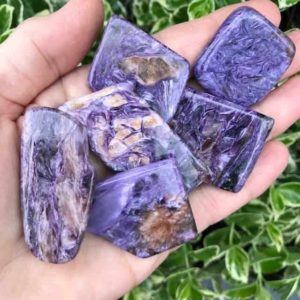
What is Charoite Stone?
Charoite (K(Ca, Na)2Si4O10(OH, F)·H2O) is a rare mineral silicate, first described in 1978 and named for the River Chara. It was recorded only from Aldan Shield, Republic of Sakha, Siberia, Russia. It is located where a Murunskii Massif syenite has intruded into and altered calcareous deposits which create a metasomatite of potassium feldspar.
Charoite colors are indeed unmistakable, ranging from light lilac to lavender and from near-violet to medium-deep violet. Within a single specimen, most charoite gemstones show many violet to purple colors, and shape with very unique patterns, often swirling, streaking, or feather-like in nature. The spinning shapes are called a charoite signature characteristic and owed to its interlocking complex fibrous crystal structure.
Charoite was named after the Chary River of Yakutia, the location where it was first discovered, around 1940. Despite the fact that it was first made sometime during the 1940s, it is considered a relatively recent gemstone, as it was not launched until 1978 on a commercial level. To this day the only source of charoite gemstones has been the Murun complex in the Sakha Republic, Siberia.
Crystal class: Prismatic (2/m); (same H-M symbol)
Crystal system: Monoclinic
Crystal habit: Fibrous, massive
Mohs scale hardness: 5 – 6
Color: Violet, lilac, light brown
Other characteristics: Weakly fluorescent
Optical properties: Biaxial (+)
How is Charoite Formed?
Charoite forms from calcareous deposits transformed by heat, pressure and injection of special chemicals (alkali-rich intrusions of nephline syenite). This process is known as’ contact metamorphism’ and is thought to be a common phenomenon in geology. Given that the forming mechanism is quite simple, it has never been fully understood why charoite occurrences are uncommon and limited only to the small region from which they are mined.
Charoite mostly appears opaque in clarity but it may seem somewhat transparent in some cases Charoite’s mild to moderate chatoyancy, best seen in species with higher translucency, is one of the most desirable characteristics. The chatoyantness adds pearly luster to the silky. Light-colored inclusions, as well as fibrous and fine-grained parallel inclusions, are very common as they are responsible for the attractive chatoyancy phenomenon (the cat’s eye effect).










